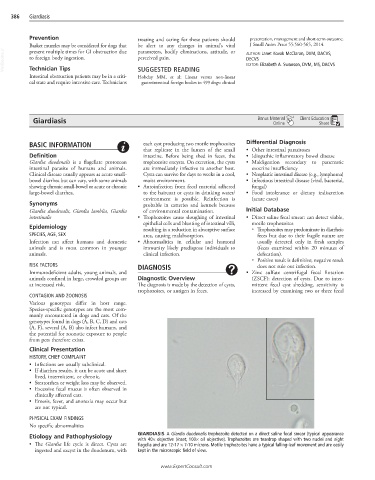Page 815 - Cote clinical veterinary advisor dogs and cats 4th
P. 815
386 Giardiasis
Prevention treating and caring for these patients should presentation, management and short-term outcome.
Basket muzzles may be considered for dogs that be alert to any changes in animal’s vital J Small Anim Pract 55:560-565, 2014.
VetBooks.ir to foreign body ingestion. perceived pain. AUTHOR: Janet Kovak McClaran, DVM, DACVS,
parameters, bodily eliminations, attitude, or
present multiple times for GI obstruction due
DECVS
EDITOR: Elizabeth A. Swanson, DVM, MS, DACVS
Technician Tips
Intestinal obstruction patients may be in a criti- SUGGESTED READING
Hobday MM, et al: Linear versus non-linear
cal state and require intensive care. Technicians gastrointestinal foreign bodies in 499 dogs: clinical
Giardiasis Bonus Material Client Education
Sheet
Online
BASIC INFORMATION each cyst producing two motile trophozoites Differential Diagnosis
that replicate in the lumen of the small • Other intestinal parasitoses
Definition intestine. Before being shed in feces, the • Idiopathic inflammatory bowel disease
Giardia duodenalis is a flagellate protozoan trophozoite encysts. On excretion, the cysts • Maldigestion secondary to pancreatic
intestinal parasite of humans and animals. are immediately infective to another host. exocrine insufficiency
Clinical disease usually appears as acute small- Cysts can survive for days to weeks in a cool, • Neoplastic intestinal disease (e.g., lymphoma)
bowel diarrhea but can vary, with some animals moist environment. • Infectious intestinal disease (viral, bacterial,
showing chronic small-bowel or acute or chronic • Autoinfection from fecal material adhered fungal)
large-bowel diarrhea. to the haircoat or cysts in drinking water/ • Food intolerance or dietary indiscretion
environment is possible. Reinfection is (acute cases)
Synonyms probable in catteries and kennels because
Giardia duodenalis, Giardia lamblia, Giardia of environmental contamination. Initial Database
intestinalis • Trophozoites cause sloughing of intestinal • Direct saline fecal smear: can detect viable,
epithelial cells and blunting of intestinal villi, motile trophozoites
Epidemiology resulting in a reduction in absorptive surface ○ Trophozoites may predominate in diarrheic
SPECIES, AGE, SEX area, causing malabsorption. feces but due to their fragile nature are
Infection can affect humans and domestic • Abnormalities in cellular and humoral usually detected only in fresh samples
animals and is most common in younger immunity likely predispose individuals to (feces examined within 20 minutes of
animals. clinical infection. defecation).
○ Positive result is definitive; negative result
RISK FACTORS DIAGNOSIS does not rule out infection.
Immunodeficient adults, young animals, and • Zinc sulfate centrifugal fecal flotation
animals confined in large, crowded groups are Diagnostic Overview (ZSCF): detection of cysts. Due to inter-
at increased risk. The diagnosis is made by the detection of cysts, mittent fecal cyst shedding, sensitivity is
trophozoites, or antigen in feces. increased by examining two or three fecal
CONTAGION AND ZOONOSIS
Various genotypes differ in host range.
Species-specific genotypes are the most com-
monly encountered in dogs and cats. Of the
genotypes found in dogs (A, B, C, D) and cats
(A, F), several (A, B) also infect humans, and
the potential for zoonotic exposure to people
from pets therefore exists.
Clinical Presentation
HISTORY, CHIEF COMPLAINT
• Infections are usually subclinical.
• If diarrhea results, it can be acute and short
lived, intermittent, or chronic.
• Steatorrhea or weight loss may be observed.
• Excessive fecal mucus is often observed in
clinically affected cats.
• Emesis, fever, and anorexia may occur but
are not typical.
PHYSICAL EXAM FINDINGS
No specific abnormalities
Etiology and Pathophysiology GIARDIASIS A Giardia duodenalis trophozoite detected on a direct saline fecal smear (typical appearance
with 40× objective (inset, 100× oil objective). Trophozoites are teardrop shaped with two nuclei and eight
• The Giardia life cycle is direct. Cysts are flagella and are 12-17 × 7-10 microns. Motile trophozoites have a typical falling-leaf movement and are easily
ingested and excyst in the duodenum, with kept in the microscopic field of view.
www.ExpertConsult.com

